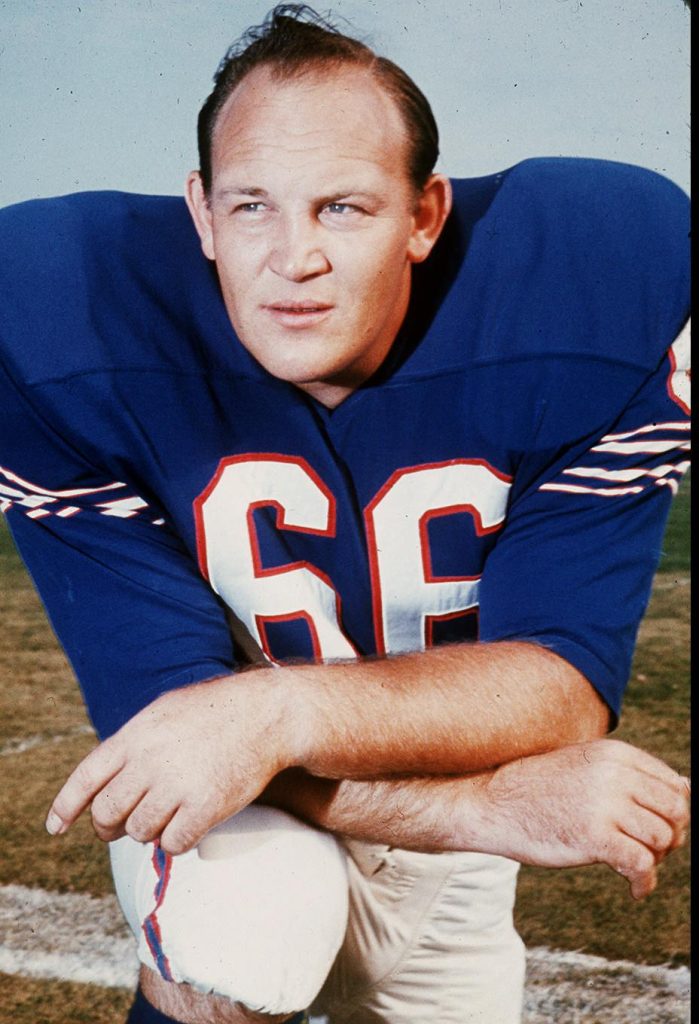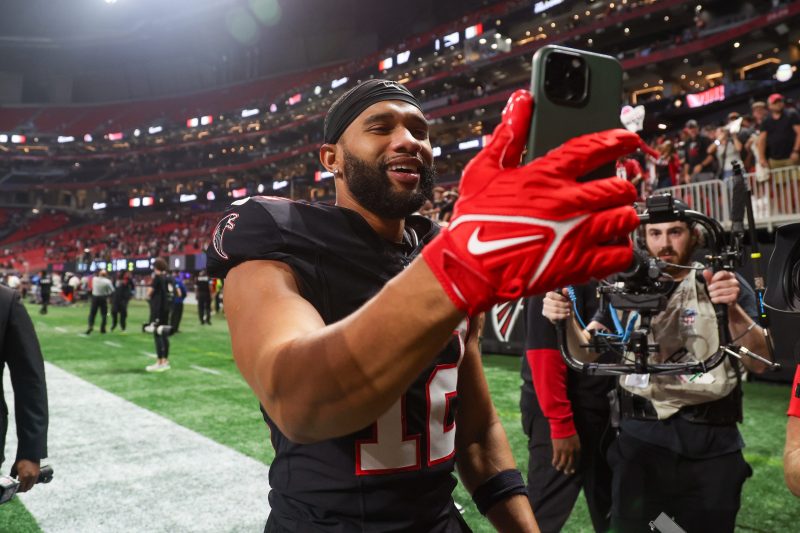Billy Shaw, Bills great and Hall of Famer, dead at 85

The first time Billy Shaw came to Buffalo, it was near the end of the inaugural 1960 season and the offensive guard from Georgia Tech wondered whether he’d be able to play in the frozen tundra.
The Buffalo Bills had just picked him in the second round of the 1961 AFL draft, which took place in November 1960 just after the college season ended, and he came to town and visited his new team at rickety War Memorial Stadium.
“It was about 55 degrees in that old locker room,” Eddie Abramoski, the Bills’ original trainer, recalled many years later. “He had a topcoat on and his eyes were flitting around. He leans over to (scout) Harvey Johnson and says, ‘Mr. Johnson, I don’t know if I can play in this cold weather’ and I’m thinking ‘Billy, you don’t know what cold weather is.’”
Abramoski recalls Johnson laughing at Shaw, a native of Mississippi who had always lived in the south, and reassuring him that he’d do “fine.”
“Fine” would be an understatement.
NFL STATS CENTRAL: The latest NFL scores, schedules, odds, stats and more.
Shaw went on to become one of the greatest players in the history of franchise and is the only player enshrined in the Pro Football Hall of Fame who played his entire career in the AFL.
Friday, Shaw passed away at the age of 85 at his home in Toccoa, Georgia, with his wife Patsy and their three daughters at his bedside. The family cited hyponatremia as the cause of his death.
In a statement, Hall of Fame President Jim Porter said: “Billy Shaw holds the distinction of being the only member of the Pro Football Hall of Fame to play his entire career in the American Football League, but while that fact is worthy of noting and nice to recite, it comes nowhere near providing the reason he was elected as a member of the Class of 1999. Billy’s all-around athleticism brought a new dimension to the guard position and made the 1960s Buffalo Bills a formidable opponent capable of bruising opponents with a punishing rushing attack. And while Billy could be unforgiving to anyone in his way on the football field, he was the classic example of the ‘Southern gentlemen’ off the field to everyone he encountered.”
During his nine-year career with the Bills, you could point to any play of any game to see just how good a player Shaw was. Shaw leading Cookie Gilchrist around the corner, destroying would-be tacklers, was one of the most enduring sights in those early years of the franchise.
His skill was unmatched, his technique was perfect, his composure never wavered. And the defining game of his career – when all three of those attributes melded together in symphonic harmony – came appropriately enough in the most important game Shaw played as a Bill.
It was the 1964 AFL championship game against the San Diego Chargers at War Memorial Stadium, and that cold December day, Shaw, ignoring those elements he once feared, put on exactly the kind of performance that lands a player in the Hall of Fame.
Shaw’s opponent was Ernie Ladd, the mountainous star defensive tackle of the Chargers. Ladd was every bit as feared in the AFL as Deacon Jones in the NFL, a 6-foot-9, 290-pound quarterback-devouring, running back-swallowing machine. And while Ladd was a physical beast, his nickname “Big Cat” was derived from his unusual speed for a man his size.
However, before the game, Ladd fumbled away any physical advantage he may have had over Shaw.
“When they introduced the San Diego players, Ladd ran out between the goal posts, then pointed across the field at me,” Shaw remembered. “That’s what got me ready.”
Ladd had seven inches and 40 pounds on Shaw, but by the time Buffalo’s 20-7 victory was complete, the Big Cat had been reduced to a little kitten. The Bills rushed for 219 yards, including 122 by Gilchrist, most of them following in the cleat marks Shaw had implanted on Ladd’s body.
“When you had a game against the Bills, you had to bring your lunch because Billy would battle you for the entire game,” said former Kansas City linebacker Bobby Bell, also a Hall of Famer.
Shaw was selected in the second round of the 1961 AFL draft, the 11th player chosen overall. He had a solid rookie season, but when Lou Saban became head coach of the Bills prior to 1962, one of his first assessments of the team was that Shaw had the potential to be much better than he was.
“We studied the films of his play after we took over that winter,” Saban said. “He needed additional polishing to become a good player. That’s when we decided to put him up against Tom Sestak every day in practice. He had to get better if he wanted to survive in that matchup. I told him, ‘If you want to be the best, you have to go up against the best.’”
Shaw and Sestak pounded on each other every day, and both players benefited as they were selected to the AFL’s all-time team.
“Those were some battles,” Shaw said. “I like to think that I had some influence in the way Tom progressed as a player, and he certainly was instrumental in my becoming a better player.”
Abramoski, who was Shaw’s presenter at his Hall of Fame induction, maintained in the 1990s when he was nearing his end as the Bills’ trainer that “Billy Shaw could have played today.”
Shaw was so talented that Tom Landry, the legendary coach of the Dallas Cowboys, thought he could have played linebacker in the NFL, even though he never played the position at Georgia Tech.
The Cowboys, who had also begun play in 1960, waited until the 14th round of the 1961 NFL draft to pick Shaw, and that was enough for Shaw to choose to sign with Buffalo rather than Dallas.
“I never played linebacker before and I just didn’t want to try to play a new position,” said Shaw. “I signed with the Bills because they were going to play me at positions that I was used to playing.”
From 1961 through 1969, Shaw never stopped rewarding the Bills for the faith they showed in him. He anchored Buffalo’s stout offensive line while playing his way into eight AFL all-star games and onto pro football’s all-decade team of the 1960s. More importantly, he helped the Bills win three straight AFL East Division titles and two AFL championships.
He had to wait 30 years after his career ended to earn the ultimate respect from the Hall of Fame voters who righted a long overdue oversight in 1999.
“Waiting 30 years made it very, very special,” Shaw said. “And to represent all of the guys that toiled in the AFL in obscurity for those many years makes it all much more special. If Ron Wolf (the former NFL executive who played a key role in his election) walked through my door, I wouldn’t know him because I don’t think I ever met him, but it means a great deal to me to hear what he said.
“I did what I thought I could do on the field and I had no control over whether I did or didn’t get in. I have my own private, personal feelings about my career and if other people didn’t share those, that’s the way life is. I didn’t make a big deal about it, but since it happened, it’s a major event in my life.”
And though he retired after the 1969 season, thus never getting the chance to play for the Bills in the NFL when it merged with the AFL in 1970, he never forgot his time in Buffalo and cherished every minute, even those cold, cold days at the old Rockpile.
“I came to Buffalo when I was 21, just married, my first child was born there, and I left when I was 30,” Shaw recalled. “So up to that point I lived a third of my life in Buffalo and it was the most important time of my life. I matured as an athlete, but more importantly I matured as a man. A lot of the characteristics and principles of the people of Buffalo are instilled in my character, and I cherish that.”
Sal Maiorana has covered the Buffalo Bills for four decades including 35 years as the full-time beat writer for the D&C, and he has written numerous books about the history of the team. He can be reached at maiorana@gannett.com, and you can follow him on Twitter @salmaiorana.
We occasionally recommend interesting products and services. If you make a purchase by clicking one of the links, we may earn an affiliate fee. USA TODAY Network newsrooms operate independently, and this doesn’t influence our coverage.







